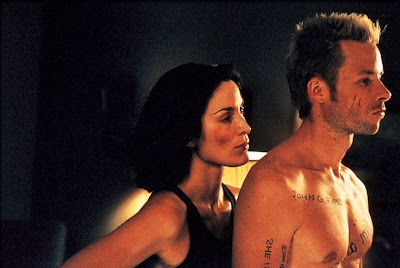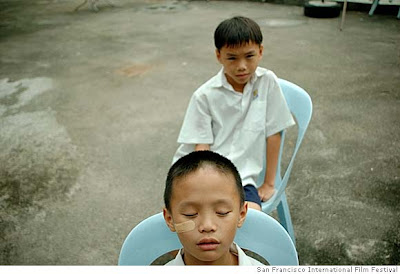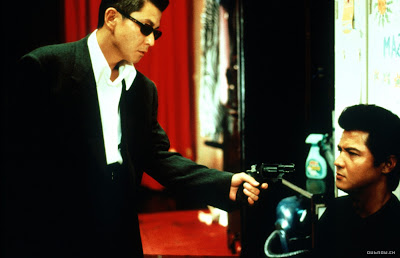
Memento. 2000. Written and directed by Christopher Nolan, based on the short story "Memento Mori" by Jonathan Nolan. Produced by Suzanne Todd and Jennifer Todd. Cinematography by Wally Pfister. Edited by Dody Dorn. Music by David Julyan. Production design by Patti Podesta. Costume design by Cindy Evans.
Cast: Guy Pearce (Leonard), Carrie-Anne Moss (Natalie), Joe Pantoliano (Teddy), Mark Boone Jr. (Burt), Jorja Fox (Leonard's Wife), Stephen Tobolowsky (Sammy), Callum Keith Rennie (Dodd).
"Now, where was I?" These are the last spoken words (or are they the first?) of Christopher Nolan's Moebius strip of a film, Memento. The speaker of these words, Lennie (Guy Pearce), is obsessed with finding the man who raped and murdered his wife (Jorja Fox). Nolan's film is yet another entry in the well-worn neo-noir genre, much like his first film, Following, in which a man who decides to follow random strangers on the street eventually becomes sucked into the lives of the people he follows. The two films share a more significant similarity: they enliven their rather standard neo-noir scenarios by playing with structure and chronology. Following chops up its narrative by presenting scenes from the beginning, middle, and ending of the story, forcing us to reassemble the plot in our own mind. Memento rearranges its sequences by using a Betrayal-like backward chronology, which is, however, complicated by linear black-and-white inserts between scenes that show us Lennie talking on the phone to an unknown person.
Memento represents a major leap forward from Nolan's first effort in that it continually questions its own method of storytelling, casting serious doubt about whether a "proper" order to this story, or any other, can even exist. "Do you realize what a metaphysical can of worms this opens up?" John Cusack's character asks in Being John Malkovich, another film dealing with the question of what constitutes identity. We could very well ask this question of the central situation depicted in Memento.
So in the spirit of Lennie's character, let us consider the known facts. Fact one: insurance investigator Lennie's wife was raped and murdered. Fact two: during the attack, as he attempted to defend his wife, Lennie suffered a blow to the head, causing the mental condition that provides the plot's impetus -- he has lost his short term memory, allowing him to retain information for only about a few minutes at a time. As he constantly explains, he does not suffer from amnesia; he remembers who he is, and his life up until his wife's murder, but he is unable to create new memories. Fact three: the perpetrator was a man named John G. These are the only things that are known for sure. Armed with this information, all the while struggling to function with his handicap, Lennie sets out to find his wife's killer.
Lennie's condition is handled throughout the film in various ways. Beyond the obvious distress and confusion Lennie suffers, it also occasions many instances of humor that occur throughout the story. Lennie befriends a man who calls himself Teddy (Joe Pantoliano), who often expresses exasperation at how Lennie explains his condition and other events over and over. "But I can keep telling the same jokes," Teddy says. However, his condition also allows people to take advantage of him, for example, perhaps, Natalie (Carrie-Anne Moss), the bartender he meets during his investigation.
To aid himself and simply to cope with his handicap, Lennie writes notes to himself, and carries a Polaroid to snap photos of the people he meets, jotting down their names and relevant information on the photos. Of Teddy, he writes, "Don't believe his lies." Of Natalie, he writes, "She has lost someone also. She will help you out of pity." As he explains to the caller during the black-and-white insert scenes, it is important to have a logical system in order to function. Since handwritten notes can be lost or hopelessly mixed up, he tattoos directly onto his skin the most important information, such as "John G. raped and murdered your wife."
Memento's structure throws us for a loop in two senses. It replicates Lennie's condition in its backward structure, forcing us to rely on our own memory of earlier (that is, later) scenes in order to make sense of later (that is, earlier) scenes. But, more importantly, it calls into question, and indeed even mocks, the value of the act of detection. In the film's first scene, which begins with a Polaroid of a murdered man fading into white, we see Lennie killing his "friend," Teddy. Why? Once we understand that the story will be told backwards, we are somewhat reassured that all answers will be revealed at the "end" of the film. But by the end, the rug is pulled out from under us and it becomes impossible to know for sure what to think, most significantly since the film's last scenes strongly suggest that Lennie may not in fact be quite the helpless victim we have assumed him to be all along.
Memento excels in posing its philosophical and metaphysical queries through the direct action of the plot, never allowing the pace to flag by taking its own conceit too seriously. Lennie, much as he did in his former life as an insurance investigator, relies on careful records of fact and observation in order to solve his own mystery. He depends on mechanical methods of observation, most notably his trusty Polaroid. He even extols his methods as superior to memory, noting to Teddy that memories can distort, using as his example the perennial unreliability of eyewitness testimony. However, there are significant instances where his system fails him. One example concerns Natalie, whom we have been fooled into thinking of as someone who is there to help Lennie in the film's early scenes. Later, however, she bitterly mocks his condition, calling him a "retard," telling him she can even call his dead wife a whore, and it won't matter since he will soon forget it anyway. She manages to goad Lennie into hitting her in the face. She leaves, while Lennie frantically searches for a pen to write down what has just happened. But he loses the memory, and Natalie is able to explain he bruises by telling him a drug dealer she works for, and wants Lennie to get rid of, beat her.
In fact, Lennie's condition makes his quest an exercise in futility and absurdity. As Teddy says late in the film, what good is getting revenge if it will only be forgotten moments later? However, Lennie rejects, or professes to reject, this assessment of his situation. "I must believe there is a world outside myself," he says. "If I close my eyes, the world does not disppear." Justice done will still be justice done, whether or not he remembers it.
Lennie's condition not only allows Memento to pose serious questions about identity, but also allows the film to function as a brilliant parody of the neo-noir genre. There are many instances where Nolan punctures the hallmarks of this type of film. In one scene Lennie finds himself running, and asks himself why he is running. He looks around and sees another man near him also running and thinks, "Oh, I'm chasing this guy." But as the man begins shooting at him, he realizes, "Wait, he's chasing me!" The desk clerk at the hotel where Lennie is staying rents two rooms for Lennie, explaining, "We're a little slow this month." Natalie, skeptical about the truth of Lennie's condition, conducts an experiments. She has a bar patron, herself, and Lennie all spit into a mug of beer, after which she successfully serves it to him.
Christopher Nolan, with both Following and this film, proves himself to be a director well worth close attention. Nolan's crisp, precise script (based on a short story by his brother Jonathan) moves at a swift clip, capturing the loops of double-crosses, lies, betrayals, and "explanations" which prove to be anything but. Memento is also anchored by excellent performances all around by actors who acquit themselves with letter-perfect precision in keeping the audience guessing as to their true motives and affiliations. Especially fine is Joe Pantoliano, who proves once again, as he has in such films as Midnight Run and The Matrix, that he is one of the best character actors currently working. Guy Pearce is also impressive, effectively and poignantly conveying the confusion and uncertainty of Lennie's struggle to cling to a sense of who he is.
.jpg)







